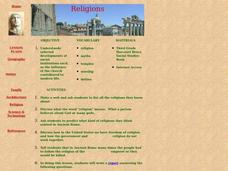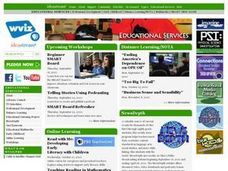Mr. Roughton
Roman Empire
Does the United States parallel the Roman Empire in any way? Young historians work with four documents in order to answer this query as part of a structured DBQ assignment.
Curated OER
Ancient Rome
Students complete pre reading, writing, during reading, and interdisciplinary activities for the book Ancient Rome. In this reading lesson plan, students complete journal entries, go over vocabulary, answer short answer questions, have...
Curated OER
Ancient Rome
In these ancient Rome worksheets, students read a passage about the gods and goddesses of ancient Rome and then underline key words from the passage. Students use the words to complete the myth about Ceres, goddess of agriculture.
Council for Economic Education
Fall of Rome
What led to the fall of Rome? Scholars have debated the question since the end of the great empire. Young historians consider the same question through an economic lens using an engaging lesson that involves a hands-on evaluation of the...
Curated OER
Primary History: City of Rome
In this researching Ancient Rome worksheet, students investigate information about the Forum, temples, catacombs, travel, Emperors on coins and in paintings, rulers Caligula, Claudius, Nero, Hadrian, and Constantine; and government....
Curated OER
Religions
Students write a report on Roman religions. In this religion lesson, students make a web including all the religions they know about, discuss what religion means and predict what kind of religions existed in Ancient Rome. ...
Curated OER
Newscast From An Ancient City
Seventh graders produce a newscast from an Ancient Roman city. In this journalism and history activity, 7th graders work in groups to dramatize a historical event from the Roman Empire. students sequence the events, role-play, and create...
Curated OER
Travel Agent to the Ancient World
Students persuade others to visit ancient times. For this ancient civilizations lesson, students participate in a webquest that requires them to encourage others to visit ancient Greece, ancient Israel, Ancient Rome, ancient China,...
Curated OER
What's Rome Got to Do With it?
Sixth graders examine the government of ancient Rome as well as their home country. They discover the basic structure of the government of Rome, their country, and another country.
Curated OER
Following the Leaders
Examine the historic election of Pope Benedict XVI and reflect on the challenges he faces as the new leader of the Catholic Church. This New York Times instructional activity investigates how other world leaders are chosen in different...
Curated OER
Going Greek
Third graders learn about the life of a young boy in Greece and all about his cultural heritage. Pupils gather information about the history, culture, and the many influences the ancient Greeks had on modern day society. Terrific video...
Curated OER
Marcus Aurelius
In this Marcus Aurelius worksheet, students read a detailed biographical text of the Roman emperor. Students answer 6 true/false questions and 6 fill in the blank.
Curated OER
Guidelines for Governing: Utopia and The Prince
Students explore the power of the Church in government. In this literature lesson, students read Sir Thomas More's Utopia and Niccolo Machiavelli's The Prince. Students respond to questions regarding the works and discuss them.
Curated OER
Who Was Marc Antony?
High schoolers explore the relationship between Marc Antony and Cleopatra. In this World History lesson, students research Marc Antony, Julius Caesar and Cleopatra, then answer specific questions about how they are all...
Constitutional Rights Foundation
Puritan Massachusetts: Theocracy or Democracy?
Was Puritan society governed as more of a theocracy or democracy? After comparing and contrasting a series of primary source documents, middle and high schoolers form small groups and debate the question.
Curated OER
Lesson on Education for Global Peace
Fifth graders explore the Canadian Charter of Rights and Freedoms. In this human rights instructional activity, 5th graders create their own country, country flag, and charter of rights and freedoms after they have studied the Canadian...
Curated OER
Introducing Elections Unit
Students discover the political parties of our country by participating in a role playing activity. In this U.S. Government lesson, students visit several different classrooms that each represent one of the political parties in the...
Curated OER
"Ancora Imparo" (Still I Am Learning)
Students study the Italian Renaissance, its impact, and origin. In this Italian Renaissance lesson, students study the Renaissance via the ancient civilizations and political geography of various countries. Students study the art prior...
ProCon
Is Homework Beneficial?
Does homework improve student achievement, or does it increase stress? Scholars use the included debate topics website to prepare for a class discussion or debate about whether homework is advantageous. After reading a brief background...
Penguin Books
Gulliver's Travels Teacher's Notes
Who are "the most pernicious race of little odious vermin that nature ever suffered to crawl upon the surface of the earth”? Readers of Gulliver’s Travels will learn the answer, as the journey with Lemuel Gulliver to Lilliput,...
Curated OER
Master Spy
Students explain that a code is a system of symbols, letters, words, or signals that are used instead of ordinary words and numbers to send messages or to store information. They practice deciphering a variety of secret codes used in...
Curated OER
Geometry of Democracy
Students explore the architecture of New England by identifying geometric shapes. In this architectural lesson, students examine photographs of classic building architecture and use a transparency to trace geometric shapes they...
Curated OER
Gothic Period
Students write down information on their outline from the Gothic PPT presentation. Then, they sketch a chair from the Gothic time period by looking through in magazines to find a pictures of a piece of furniture or architectural detail...
Curated OER
Coordinate Connections
Sixth graders complete several activities that involve coordinates and graph paper. They visualize and identify geometric shapes after applying transformations on a coordinate plane. Finally, 6th graders draw and label a coordinate...























